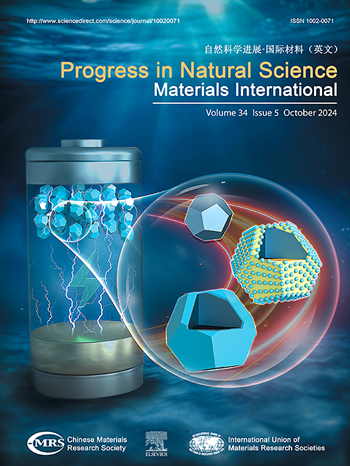Molecular dynamics simulations of microstructure and dislocation evolution of single-crystal Ni-based superalloys under femtosecond laser loading
IF 7.1
2区 材料科学
Q2 MATERIALS SCIENCE, MULTIDISCIPLINARY
Progress in Natural Science: Materials International
Pub Date : 2024-10-01
DOI:10.1016/j.pnsc.2024.06.008
引用次数: 0
Abstract
In this paper, molecular dynamics simulations are employed to investigate the temperature, stress distribution, microstructure and evolution of dislocations in single-crystal Ni-based superalloys during femtosecond laser drilling of micro-holes. The results indicate that the temperature and stress variations in the model system increase with the increment of laser energy density. The pulse width has a relatively low effect on temperature and stress variations. At the same time, an increase in dislocations is primarily related to energy density and stress distribution. The number of dislocations increases with the energy density, with the 1/6<112> dislocation showing the highest increase ratio. The densest concentration of dislocations occurs at the hole walls. Dislocations and stacking faults gradually penetrate the precipitate phase under the influence of temperature and reach a stable state as the relaxation time increases. The above research findings provide important theoretical guidance for understanding the microstructure evolution and changes in the mechanical properties of single-crystal Ni-based superalloys during femtosecond laser processing of micro-holes.
飞秒激光加载下单晶镍基超合金微观结构和位错演变的分子动力学模拟
本文采用分子动力学模拟研究了飞秒激光钻微孔过程中单晶镍基超合金的温度、应力分布、微观结构和位错演变。结果表明,模型系统中的温度和应力变化随着激光能量密度的增加而增大。脉冲宽度对温度和应力变化的影响相对较小。同时,位错的增加主要与能量密度和应力分布有关。位错数量随能量密度的增加而增加,其中 1/6<112> 位错的增加比率最高。位错最密集的地方是孔壁。差排和堆积断层在温度的影响下逐渐渗透到析出相中,并随着弛豫时间的增加而达到稳定状态。上述研究成果为理解单晶镍基超合金在飞秒激光加工微孔过程中的微结构演变和力学性能变化提供了重要的理论指导。
本文章由计算机程序翻译,如有差异,请以英文原文为准。
求助全文
约1分钟内获得全文
求助全文
来源期刊
CiteScore
8.60
自引率
2.10%
发文量
2812
审稿时长
49 days
期刊介绍:
Progress in Natural Science: Materials International provides scientists and engineers throughout the world with a central vehicle for the exchange and dissemination of basic theoretical studies and applied research of advanced materials. The emphasis is placed on original research, both analytical and experimental, which is of permanent interest to engineers and scientists, covering all aspects of new materials and technologies, such as, energy and environmental materials; advanced structural materials; advanced transportation materials, functional and electronic materials; nano-scale and amorphous materials; health and biological materials; materials modeling and simulation; materials characterization; and so on. The latest research achievements and innovative papers in basic theoretical studies and applied research of material science will be carefully selected and promptly reported. Thus, the aim of this Journal is to serve the global materials science and technology community with the latest research findings.
As a service to readers, an international bibliography of recent publications in advanced materials is published bimonthly.

 求助内容:
求助内容: 应助结果提醒方式:
应助结果提醒方式:


